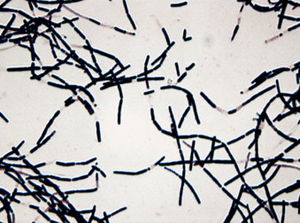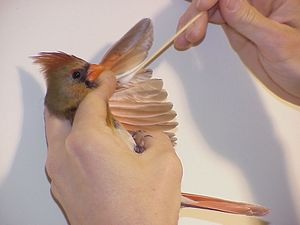Bacillus licheniformis: Difference between revisions
| Line 41: | Line 41: | ||
''Bacillus licheniformis'' is a rod-shaped, gram positive bacterium. It tends to form spores in soil which makes it desirable to be used for the industrial purposes such as the production of enzymes, antibiotics, and small metabolites. It produces an variety of extracellular enzymes that is associated with the cycling of nutrients in nature. | ''Bacillus licheniformis'' is a rod-shaped, gram positive bacterium. It tends to form spores in soil which makes it desirable to be used for the industrial purposes such as the production of enzymes, antibiotics, and small metabolites. It produces an variety of extracellular enzymes that is associated with the cycling of nutrients in nature. | ||
The complete nucleotide sequence of ''Bacillus licheniformis'' consists of the ATCC 14580 genome, which has a circular chromosome of 4,222,336 bp (base pairs) which in itself contains 4,208 predicted protein-coding genes (average size of 873 bp), 7 rRNA operons, and 72 tRNA genes. | The complete nucleotide sequence of ''Bacillus licheniformis'' consists of the ATCC 14580 genome, which has a circular chromosome of 4,222,336 bp (base pairs) which in itself contains 4,208 predicted protein-coding genes (average size of 873 bp), 7 rRNA operons, and 72 tRNA genes. The GC content is 46.2% and no plasmids were detected. | ||
The chromosome of ''Bacillus licehniformis'' has large regions that are similar to ''Bacillus subtilis'' and ''Bacillus halodurans.'' Since about 80% of the coding sequence of ''Bacillus licheniformis'' contain ''Bacillus subtilis'' orthologs, it is considered part of the ''subtilis'' group. But, although similar to ''Bacillus subtilis,'' they differ in the amount and location of prophages, transposable elements, extracellular enzymes, and secondary metabolic pathway operons. | The chromosome of ''Bacillus licehniformis'' has large regions that are similar to ''Bacillus subtilis'' and ''Bacillus halodurans.'' Since about 80% of the coding sequence of ''Bacillus licheniformis'' contain ''Bacillus subtilis'' orthologs, it is considered part of the ''subtilis'' group. But, although similar to ''Bacillus subtilis,'' they differ in the amount and location of prophages, transposable elements, extracellular enzymes, and secondary metabolic pathway operons. | ||
Revision as of 17:35, 3 May 2007
A Microbial Biorealm page on the genus Bacillus licheniformis
Classification
Higher order taxa
cellular organisms; Bacteria; Firmicutes; Bacilli; Bacillales; Bacillaceae; Bacillus; Bacillus licheniformis
Species
|
NCBI: Taxonomy |
Bacillus licheniformis
Description and significance
Bacillus licheniformis is a bacterium that is commonly found in soil and bird feathers. Birds that tend to stay on the ground more than the air (i.e. sparrows)and on the water (i.e. ducks) are common carriers of this bacterium; it is mostly found around the bird's chest area and back plumage.
Bacillus licheniformis is part of the subtilis group along with Bacillus subtilis and Bacillus pumilus. These bacteria are commonly known to cause food poisoning and food spoilage. Bacillus licheniformis also is known for contaminating dairy products. Food borne outbreaks usually involve cases of cooked meats and vegetables, raw milk, and industrially produced baby food contaminated with Bacillus licheniformis.
This bacterium, although detrimental, can be modified to become useful. Researchers are trying to turn it into a nutritious livestock feed by fermenting it with the non-digestable proteins on bird feathers. There is also research about the possibility that Bacillus licheniformis causes changes in color in birds' feathers; this will provide information on the evolution of molting. Also, cultures of Bacillus licheniformis are made to retain its protease, which is in turn used in laundry detergent.
Genome structure
Bacillus licheniformis is a rod-shaped, gram positive bacterium. It tends to form spores in soil which makes it desirable to be used for the industrial purposes such as the production of enzymes, antibiotics, and small metabolites. It produces an variety of extracellular enzymes that is associated with the cycling of nutrients in nature.
The complete nucleotide sequence of Bacillus licheniformis consists of the ATCC 14580 genome, which has a circular chromosome of 4,222,336 bp (base pairs) which in itself contains 4,208 predicted protein-coding genes (average size of 873 bp), 7 rRNA operons, and 72 tRNA genes. The GC content is 46.2% and no plasmids were detected.
The chromosome of Bacillus licehniformis has large regions that are similar to Bacillus subtilis and Bacillus halodurans. Since about 80% of the coding sequence of Bacillus licheniformis contain Bacillus subtilis orthologs, it is considered part of the subtilis group. But, although similar to Bacillus subtilis, they differ in the amount and location of prophages, transposable elements, extracellular enzymes, and secondary metabolic pathway operons.
Cell structure and metabolism
Bacillus Licheniformis is a Gram positive, rod-shaped, thermophillic bacterium. Its optimal growth temperature is 50°C, but it can also survive at much higher temperatures. Its optimal temperature for enzyme secretion is 37°C. This bacterium can survive harsh environments by turning into spore-form; when conditions are good, it will turn back into a vegetative state.
Bacillus licheniformis produces a protease that can survive at high pH levels. This protease is a desired ingredient in laundry detergent due to its ability to be used in low temperatures, which prevents shrinkage and fading colors.
Ecology
Bacillus licheniformis forms spores in soil which makes it desirable to be used for the industrial purposes such as the production of enzymes, antibiotics, and small metabolites. It produces an variety of extracellular enzymes that is associated with the cycling of nutrients in nature. It is an apathogenic soil organism that is mostly associated with plant and plant materials in nature. Although the most common thing to isolate this bacterium from is soil, it is believed that Bacillus licheniformis can actually be isolated from practically anywhere since it produces highly resistant endospores that are spread around with dust.
Ecologists are studying the effects of Bacillus licheniformis on bird feathers. It is believed that this bacterium is involved in the evolution of molting and patterns of color in birds due to its feather degrading capability.
Bacillus licheniformis is also known to cause food poisoning in humans; especially high in contamination rates are products such as raw milk, dairy, vegetables, processed baby foods, and cooked meats.
Pathology
Bacillus licheniformis is commonly associated with food spoilage and poisoning. It causes bread spoilage, or more specifically, a condition called "ropy bread." Contamination will make the bread sticky and stringy; the ropy bread will also start to develop a strong odor after contamination. Rope spores is what causes the spoilage; unfortunately these spores do not get killed during the baking process.
It can also cause food-borne gastro-enteritis, which is infection of the gut which could lead to a life threatening condition called Septicaemia. Septicaemia is blood poisoning, it is classified as having a large amount of bacteria in the blood. Dairy products are at increased risk of being contaminated with toxin-producing isolates of Bacillus licheniformis. Cooked meats, vegetables, and processed baby foods are also at risk.
The symptoms include stomach pains, (acute) diarrhea, and possible vomiting. These have an onset time of 2-14 hours and last no longer than 36 hours.
Bacillus licheniformis, although usually associated with the gut and gastrointestinal tract, can also cause distress in other parts of the body. It can cause ophthalmitis, which is the inflammation of the eye. It can even go as far as causing abortions in pregnancies.
Application to Biotechnology
Researchers are trying to recycle bird feathers by turning them into nutritious food for livestock. As mentioned, Bacillus licheniformis is commonly found on bird feathers; by fermatation with Bacillus licheniformis, the large amounts of non-digestible proteins found in the feathers can turn into a feather meal for livestock. This is desired because it is cheap and nutritious.
Another way that Bacillus licheniformis is useful is that it can give more information about the evolution of molting and patterns of color in birds due to its feather degrading capability. Ecologists are looking for signs of association between the plumage feathers and Bacillus licheniformis activity.
Bacillus licheniformis is also an important ingredient in laundry detergent. Since it can grow in alkaline conditions, it produces a protease that can survive at high pH levels. The protease has an optimum pH at around 9 and 10, which is desirable since it can remove protein-comprised dirt in clothes. Researchers culture and isolate this protease to add it into detergents. This protease prevents shrinkage and fading colors since it allows lower temperatures to be used, which in turn lowers energy use as well.
Bacillus licheniformis is used to make the polypeptide antibiotic Bacitracin, which ironically is used to inhibit its own growth.
Current Research
Enter summaries of the most recent research here--at least three required
References
http://en.wikipedia.org/wiki/Bacillus_licheniformis
Edited by Thu Mai, student of Rachel Larsen and Kit Pogliano


